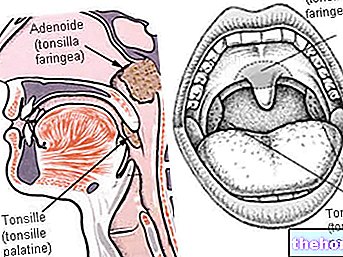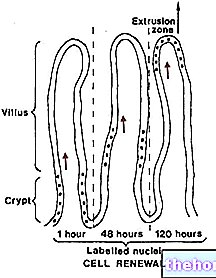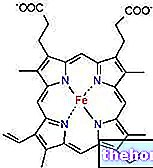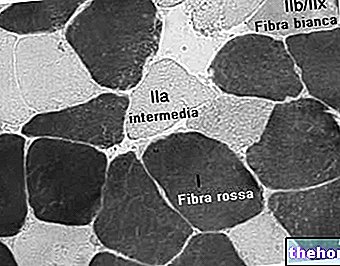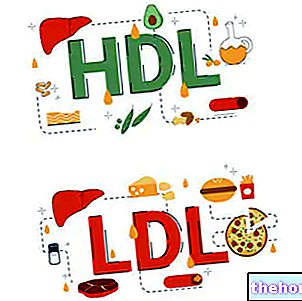Generality
Dopamine is an important neurotransmitter of the catecholamine family, with a control function on: movement, the so-called working memory, the sensation of pleasure, reward, prolactin production, sleep regulation mechanisms, some cognitive faculties and attention span.

The dopaminergic area includes several sites of the brain, including the pars compacta of the substantia nigra and the ventral tegmental area of the midbrain.
Abnormal dopamine levels are responsible for several pathological conditions. One of these pathological conditions is the well-known Parkinson's disease.
What is dopamine?
Dopamine is an organic molecule, belonging to the catecholamine family, which plays an important role as a neurotransmitter in the brain of humans and other animals.
Dopamine is also the precursor molecule from which cells, by means of specific processes, derive two other neurotransmitters of the catecholamine family: norepinephrine (or noradrenaline) and epinephrine (or adrenaline).
WHAT ARE NEUROTRANSMITTERS?
Neurotransmitters are chemicals that allow cells in the nervous system, so-called neurons, to communicate with each other.
In neurons, neurotransmitters reside inside small vesicles; the vesicles are comparable to sacs, delimited by a double layer of phospholipids, very similar to that of the cytoplasmic membrane of a generic healthy eukaryotic cell.
Inside the vesicles, the neurotransmitters remain as it were inert, until a nerve impulse arrives in the neurons in which they reside.
The nerve impulses, in fact, stimulate the release of the vesicles by the neurons that contain them.
With the release of the vesicles, the neurotransmitters escape from the nerve cells, occupy the so-called synaptic space (which is a particular space between two very close neurons) and interact with neighboring neurons, to be precise with the membrane receptors of the aforementioned neurons . The interaction of the neurotransmitters with the neurons placed in the immediate vicinity transforms the initial nerve impulse into a very specific cellular response, which depends on the type of neurotransmitter and the type of receptors present on the neurons involved.
In simpler words, neurotransmitters are chemical messengers, which nerve impulses release to induce a certain cellular mechanism.
In addition to dopamine and its derivatives, norepinephrine and epinephrine, other important human neurotransmitters are: glycine, serotonin, melatonin, gamma-aminobutyric acid (GABA) and vasopressin.
CHEMICAL NAME OF DOPAMINE
The chemical name of dopamine is 4- (2-aminoethyl) benzene-1,2-diol.
HISTORY OF THE DOPAMINA
Curiously, dopamine is a neurotransmitter that researchers first synthesized in the laboratory and then found in human brain tissues.
Dated 1910, the credit for the laboratory synthesis of dopamine goes to George Barger and James Ewens, two English chemists of the company. Wellcome from London.
To discover, however, that dopamine is a molecule naturally present in the brain was the English researcher Kathleen Montagu, in 1957, at the laboratories of the Runwell Hospital from London.
A year after the discovery of dopamine in brain tissues, then in 1958, scientists Arvid Carlsson and Nils-Ake Hillarp, employees of the Chemical Pharmacology Laboratories of the National Heart Institute of Sweden, identified and described for the first time the role of neurotransmitter , covered with dopamine.
For this important finding and for establishing that dopamine is not only a precursor of norepinephrine and epinephrine, Carlsson also received the Nobel Prize in Physiology or Medicine.
WHERE DOES THE NAME DOPAMINE COME FROM?
The scientific community adopted the term "dopamine" because the precursor molecule, from which George Barger and James Ewens synthesized dopamine, was the so-called L-DOPA.
Chemical structure
As stated, dopamine is a catecholamine.
Catecholamines are organic molecules, in which the presence of a benzene ring joined to two hydroxyl groups OH is recurrent. This benzene ring combined with two OH hydroxyl groups has the chemical formula C6H3 (OH) 2.
In the case of dopamine, this substance consists of the union between the benzene ring with the two hydroxyl groups, typical of catecholamines, and an ethylamine group.
An ethylamine group is an organic compound in which two carbon atoms and one nitrogen participate, and which has the following chemical formula: CH2-CH2-NH2.
In light of the two chemical formulas reported above, namely that of the benzene group with the two OH groups and that of the ethylamine group, the final chemical formula of dopamine is: C6H3 (OH) 2-CH2-CH2-NH2.
The figures below show the chemical structure of a generic catecholamine, a hydroxyl group, an ethylamine group, dopamine and L-DOPA.

Figure: unlike dopamine, L-DOPA has a carboxyl group, bonded to one of the two carbon atoms of the ethylamine group. A carboxyl group - whose chemical formula is COOH - is the result of the union of a carbon with an oxygen atom and a hydroxyl group.
CHEMICAL PROPERTIES
Like many molecules made up of an ethylamine group, dopamine is an organic base.
This implies that, in an acidic environment, it is generally in a protonated form; while, in a basic environment, it is usually in a non-protonated form.
Summary: how and where does it happen?
The natural synthesis (or biosynthesis) pathway of dopamine includes four basic steps and begins with the amino acid L-phenylalanine.
In a simple and schematic way, the biosynthesis of dopamine can be summarized as follows:
L-phenylalanine ⇒ L-tyrosine ⇒ L-DOPA ⇒ dopamine
The conversion of L-phenylalanine to L-tyrosine and the conversion of L-tyrosine to L-DOPA consist of two hydroxylation reactions. In chemistry, a hydroxylation reaction is a reaction at the end of which a molecule acquires an OH hydroxyl group.
The first hydroxylation reaction, that is L-phenylalanine ⇒ L-tyrosine, occurs thanks to the intervention of an enzyme known as phenylalanine hydroxylase.
The L-tyrosine ⇒ L-DOPA reaction, on the other hand, takes place thanks to the intervention of an enzyme known as tyrosine hydroxylase.
The final step, the one that gives dopamine from L-DOPA, is a decarboxylation reaction.
In the chemical field, a decarboxylation reaction corresponds to a process at the end of which such a molecule loses one or more COOH carboxyl groups.
Providing the decarboxylation reaction that gives rise to L-DOPA is an enzyme called L-amino acid decarboxylase (or DOPA decarboxylase).
SEAT OF SYNTHESIS OF THE DOPAMINE
In the human body, the biosynthesis of dopamine is mainly done by the so-called neurons of the dopaminergic area and, to a lesser extent, by the medullary portion of the adrenal (or adrenal) glands.
Neurons of the dopaminergic area, or dopaminergic neurons, are nerve cells located in:
- Substantia nigra, precisely in the so-called Pars compacta of the substantia nigra. There substantia nigra (or black substance) takes place in the midbrain, which is one of the three main regions that make up the brain stem.
Although part of the brain stem, the substantia nigra acts under the guidance of the nuclei of the base (or basal ganglia) of the telencephalon; the telencephalon is the brain.
According to various scientific studies, the pars compacta of the substantia nigra it is the main site of dopamine synthesis, present in the human body. - Ventral tegmental area. Also located at the level of the midbrain, the ventral tegmental area has dopaminergic neurons, whose extensions reach various nervous areas, including: the nucleus accumbens, the prefrontal cortex, the amygdala and the hippocampus.
- Posterior hypothalamus. The extensions of the dopaminergic neurons of the posterior hypothalamus reach the spinal cord.
- Arcuate nucleus of the hypothalamus and paraventricular nucleus of the hypothalamus. The dopaminergic neurons of these two areas have extensions that reach the pituitary gland. Here, they have the task of influencing the production of prolactin.
- Uncertain area of the subthalamus.
DEGRADATION
The natural breakdown of dopamine into inactive metabolites can occur in two distinct ways and involves three enzymes:
- monoamine oxidase (or MAO),
- catechol-O-methyltransferase (COMT)
- the aldehyde dehydrogenase.
Both ways of natural dopamine breakdown lead to the formation of a substance known as homovanyl acid (HVA).

Figure: the two possible ways of biodegradation of dopamine. From: wikipedia.org
Functions
Dopamine performs numerous functions, both at the level of the central nervous system and at the level of the peripheral nervous system.
Regarding the central nervous system, dopamine is a neurotransmitter that participates in:
- Motion control
- The secretion mechanism of the hormone prolactin
- Checking the memory capacity
- The mechanisms of reward and pleasure
- The control of attention skills
- Control of some aspects of behavior and some cognitive functions
- The mechanism of sleep
- Mood control
- The mechanisms underlying learning
As for the peripheral nervous system, dopamine acts:
- As a vasodilator
- As a stimulant of sodium excretion, through the urine
- As a factor promoting intestinal motility
- As a factor that reduces lymphocyte activity
- As a factor that reduces insulin secretion by the islets of Langerhans (pancreatic beta cells)
DOPAMINERGIC RECEPTORS
After its release into the synaptic space, dopamine exerts its effects by interacting with the so-called dopaminergic receptors, present on the membrane of different nerve cells.
In mammals - therefore also in humans - there are 5 different subtypes of dopaminergic receptors. The names of these 5 receptor subtypes are very simple: D1, D2, D3, D4 and D5.
The response produced by dopamine depends on the dopamine receptor subtype, with which the dopamine itself interacts.
In other words, the cellular effects of dopamine vary depending on the dopamine receptor involved in the interaction.
In the brain, the density of distribution of dopaminergic receptors varies from brain area to brain area. In other words, each area of the brain has its own amount of dopaminergic receptors.
Biologists believe that this different density of receptor distribution depends on the functions that the brain areas must cover.
DOPAMINA AND MOVEMENT
The motor skills of the human being (correctness of movements, rapidity of movements, etc.) depend on dopamine which substantia nigra releases under the action of the basal ganglia.
In fact, if dopamine released from the substantia nigra is less than normal, movements become slower and more uncoordinated. Conversely, if dopamine is quantitatively higher than normal, the human body begins to perform unnecessary movements, very similar to tics.
Hence, the fine regulation of dopamine release by the substantia nigra, it is essential for the human being to move correctly, performing coordinated gestures and at the right speed.
DOPAMINE AND PROLACTIN RELEASE
Dopamine originating in the dopaminergic neurons of the arcuate nucleus and the paraventricular nucleus inhibits the secretion of the hormone prolactin by the lactotropic cells of the pituitary gland.
As it is easy to understand, the absence or reduced presence of dopamine coming from the aforementioned districts implies a greater activity of the pituitary lactotropic cells, therefore a greater production of prolactin.
Dopamine which inhibits prolactin secretion takes the alternative name of "prolactin inhibiting factor" (PIF).
To find out what the effects of prolactin are, readers can click here.
DOPAMINE AND MEMORY
Several scientific researches have shown that adequate levels of dopamine in the prefrontal cortex improve the so-called working memory.
By definition, working memory is "a system for the temporary maintenance and manipulation of information during the performance of different cognitive tasks, such as understanding," learning and reasoning ".
If dopamine levels originating in the prefrontal cortex decrease or increase, working memory begins to suffer.
DOPAMINE, PLEASURE AND REWARD
Dopamine is a pleasure and reward mediator.
In fact, according to reliable studies, the brain of the human being releases dopamine when it “experiences” pleasant circumstances or activities, such as a meal based on good food or a satisfying sexual activity.
The neurons of the dopaminergic area most involved in reward and pleasure mechanisms are those of the nucleus accumbens and the prefrontal cortex.
DOPAMINE AND ATTENTION
Dopamine originating in the prefrontal cortex supports attention skills.
Interesting research has shown that low dopamine concentrations in the prefrontal cortex are often associated with a condition known as attention deficit hyperactivity disorder.
DOPAMINE AND COGNITIVE FUNCTIONS
The link between dopamine and cognitive abilities is evident in all morbid conditions characterized by an "alteration of the dopaminergic neurons of the prefrontal cortex.
In fact, in the aforementioned morbid conditions, in addition to the aforementioned faculties of attention and working memory - also the neurocognitive functions, the ability to problem-solving etc.
Pathologies
Dopamine plays a central role in several medical conditions, including: Parkinson's disease, attention deficit hyperactivity disorder (ADHD), schizophrenia / psychosis, and addiction to certain drugs and medications.
Furthermore, according to some scientific studies, it would be responsible for the painful sensations that characterize some morbid states (fibromyalgia, restless legs syndrome, burning mouth syndrome) and the nausea associated with vomiting.
Drugs
Medicines
- Cocaine
- Amphetamines
- Methamphetamine
- Ecstasy (MDMA)
- Ritalin
- Psychostimulants
To know more:
- Parkinson's disease
- ADHD
- Schizophrenia
Curiosities and other information
To complement what has been said so far, here is some additional information regarding dopamine:
- The conversion of dopamine to norepinephrine is a hydroxylation reaction, which is done by the enzyme known as dopamine beta-hydroxylase.
Conversion of dopamine into adrenaline, on the other hand, is a reaction that takes place due to the intervention of the enzyme known as phenylethanolamine N-methyltransferase. - Recent studies have shown that the ocular retina also hosts some dopaminergic neurons.
These nerve cells have the particularity of being active during the hours of light and of silencing during the hours of darkness. - The dopaminergic receptors most present in the human nervous system are the D1 receptors, followed soon after by the D2 receptors.
When compared with the D1 and D2 subtypes, the D3, D4 and D5 receptors are present at significantly lower levels. - According to experts, drug abuse is among the circumstances that favor the release of the dopamine of pleasure and reward.
In fact, it seems that taking drugs, such as cocaine, leads to an increase in dopamine levels, just like good food or satisfying sexual activity. - Doctors plan a treatment based on dopamine injections, in the presence of: hypotension, bradycardia, heart failure, heart attack, cardiac arrest and kidney failure.
- The physiological aging, to which every human being is subject, coincides with a drop in dopamine levels in the nervous system.
According to some scientific studies, the age-related decline in brain function is due, in part, to this drop in dopamine levels in the nervous system.
See also: Dopamine Agonist Drugs

